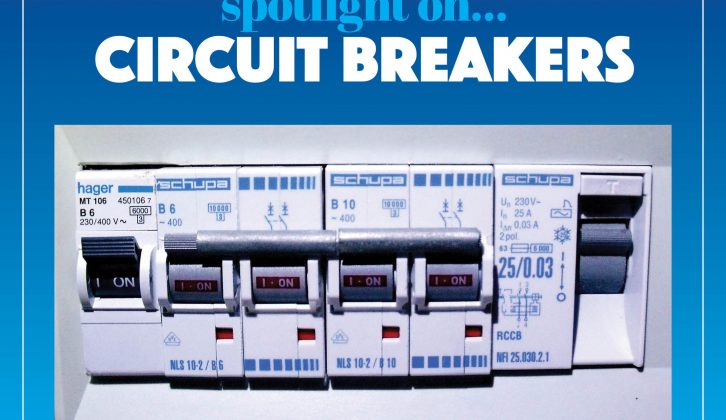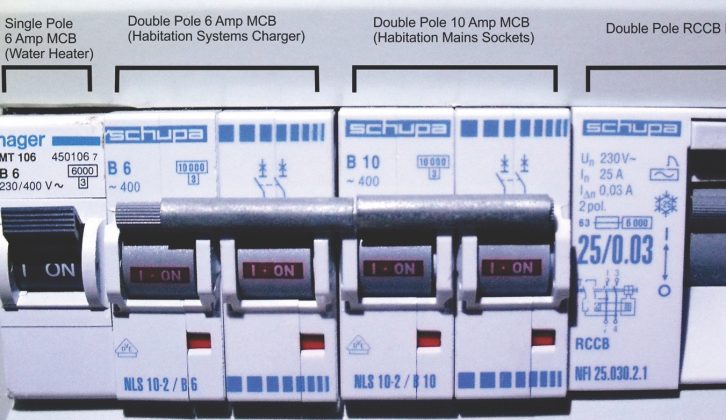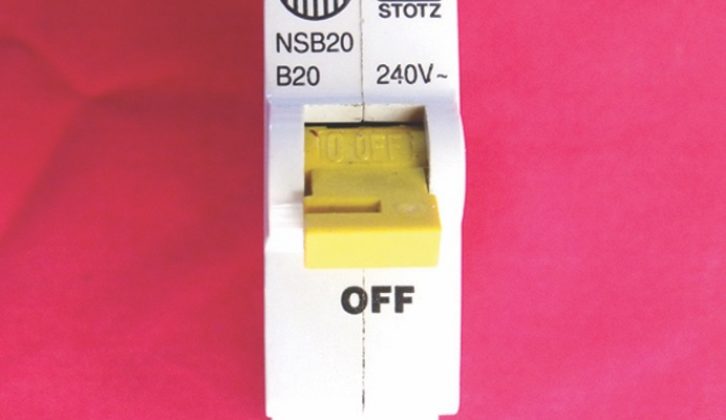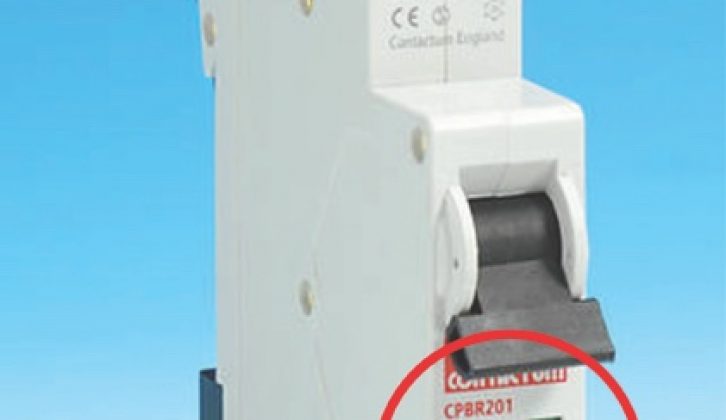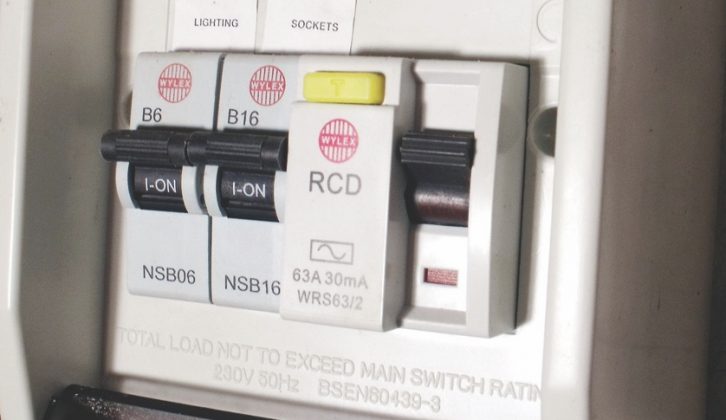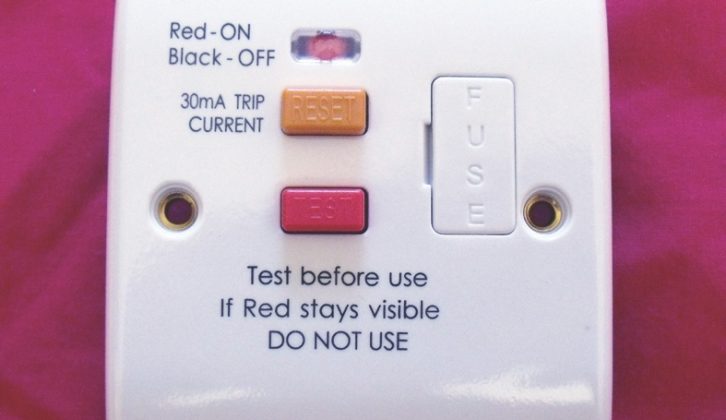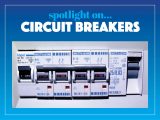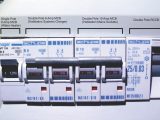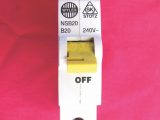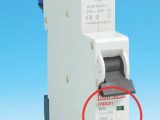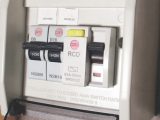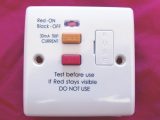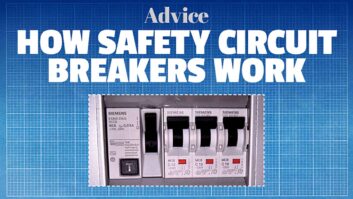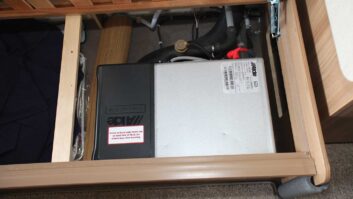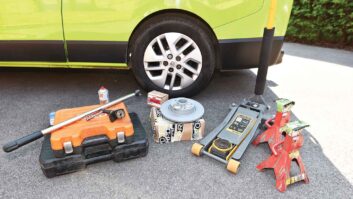Motorhome designers take into consideration two overriding constraints when planning the mains electrical supply system, namely:
1 Protection from damage and potential fire hazards caused by appliances failing and thereby exceeding the current rating of the internal mains distribution wiring.
2 Protecting the occupants of the ‘van from lethal electric shocks in the event of an appliance becoming faulty.
Overcurrent protection
In the past, overcurrent (that is, high current demand and/or short circuit) conditions were handled by wire fuse links designed to melt and thereby isolate the supply should a fault occur.
Nowadays homes, and motorhomes, are fitted with current-sensing circuit breakers – miniature circuit breakers or MCBs – that isolate the supply once a predetermined steady-state current level has been exceeded, or a short circuit occurs.
Type B MCBs (used in houses and motorhomes) have a stated maximum fixed current rating or maximum steady-state current (one they can handle continuously), which is usually printed on the front of the device preceded by a ‘B’; for example, B16 in the case of a 16A device.
MCBs operate within tight tolerances, tripping out at a point just above the stated current rating, which is not the case with a wire fuse. In practice, the current demands on the MCB are varied. With certain loads (mains vacuum cleaners being an example), a large, but brief, transient surge current can exist at switch-on, before the steady-state current condition is reached. To handle this, MCBs are designed to handle short transient currents of three to five times their rated value.
In the event of a short circuit, this current level will be exceeded for much longer and the device will trip. Once a trip condition is reached (excess steady current or short circuit), the device reacts very rapidly (typically 30-150 milliseconds) in breaking the circuit. This is much faster than a wire fuse.
One of the advantages of this type of device is that, once the reason for tripping has been removed, the breaker can be re-engaged by pushing a switch lever up on its front. No more looking for fuse wire or a replacement fuse!
Using a circuit breaker usually also keeps appliance damage to a minimum, thanks to its very fast reaction time.
It should be noted that MCBs can be single or double pole. Single-pole devices are usually placed in the live conductor, so when an overcurrent condition occurs, the live (high-voltage) feed is isolated.
This is the approach taken in the UK domestic environment, which is why correct polarity is important – if the MCB is placed in the neutral conductor, it will trigger in an overcurrent, but the high volts being supplied via the live conductor will still be connected to the faulty appliance. A double-pole MCB will break both the live and the neutral conductors in an overcurrent, ensuring the appliance has no high voltage on it, even if the connections are reversed.
Shock protection
Protection against shock is the job of the leakage current breaker. There are two types: residual current device (RCD) and residual current circuit breaker (RCCB). These have become commonplace, but years ago, the chance of being electrocuted was high.
Power supply basics
Mains power is delivered to the user via live, neutral and earth conductors.
- LIVE: Voltage on this conductor is nominally 230V above the neutral
- NEUTRAL: Voltage on this conductor is 230V below the live; it is connected to the earth by the network supplier
- EARTH: This conductor is at ground potential and also, by default, 230V below the live conductor.
Appliances draw their power from the live and neutral conductors; that is, there is a notional flow of current from the live conductor and back through the neutral conductor.
The earth is usually passive and has no current flowing through it. But it is connected to any metal casing or conductive parts with which the user might come into contact.
The 19th-century scientist Gustav Kirchhoff’s first law states that the sum of the currents flowing into a point must equal exactly the sum of the currents flowing out of it. This forms the cornerstone of the RCD/RCCB operating principle.
This means the current going into the appliance/load via the live conductor under normal conditions equals exactly the current returned via the neutral.
In the event of a fault developing, a leakage current to earth will occur. In this case, the live conductor will be supplying more current than is returning via the neutral, which will result in an imbalance in the live/neutral currents. This is detected by the RCD/RCCB, whereupon a breaker is tripped and the supply is isolated.
It is generally considered that the human body will be protected if the supply is rapidly switched off when 30 milliamperes or more of leakage current is detected.
This is why RCD/RCCBs deployed in motorhomes and domestic properties trip at a 3mA leakage current threshold and, generally, within 40 milliseconds.
It is usual to have all of the current supplied to the motorhome travelling through an RCD/RCCB before being passed to the MCBs, thereby providing blanket shock protection.
All RCD/RCCB devices come with a test button, which, when depressed, simulates a leakage current situation, whereupon the trip should operate, if the device is working correctly and is connected to a supply.
The RCBO
Another type of breaker is available, known as a residual current circuit breaker with overcurrent protection, or RCBO. This combines the properties of an RCD/RCCB and an MCB into one unit. However, these are not the norm for motorhomes.
One of the disadvantages of this type of device is that it trips in the event of a leakage current or a short circuit. This makes finding out which of the two caused the fault more difficult.
Using a circuit breaker usually also keeps appliance damage to a minimum, thanks to its very fast reaction time
